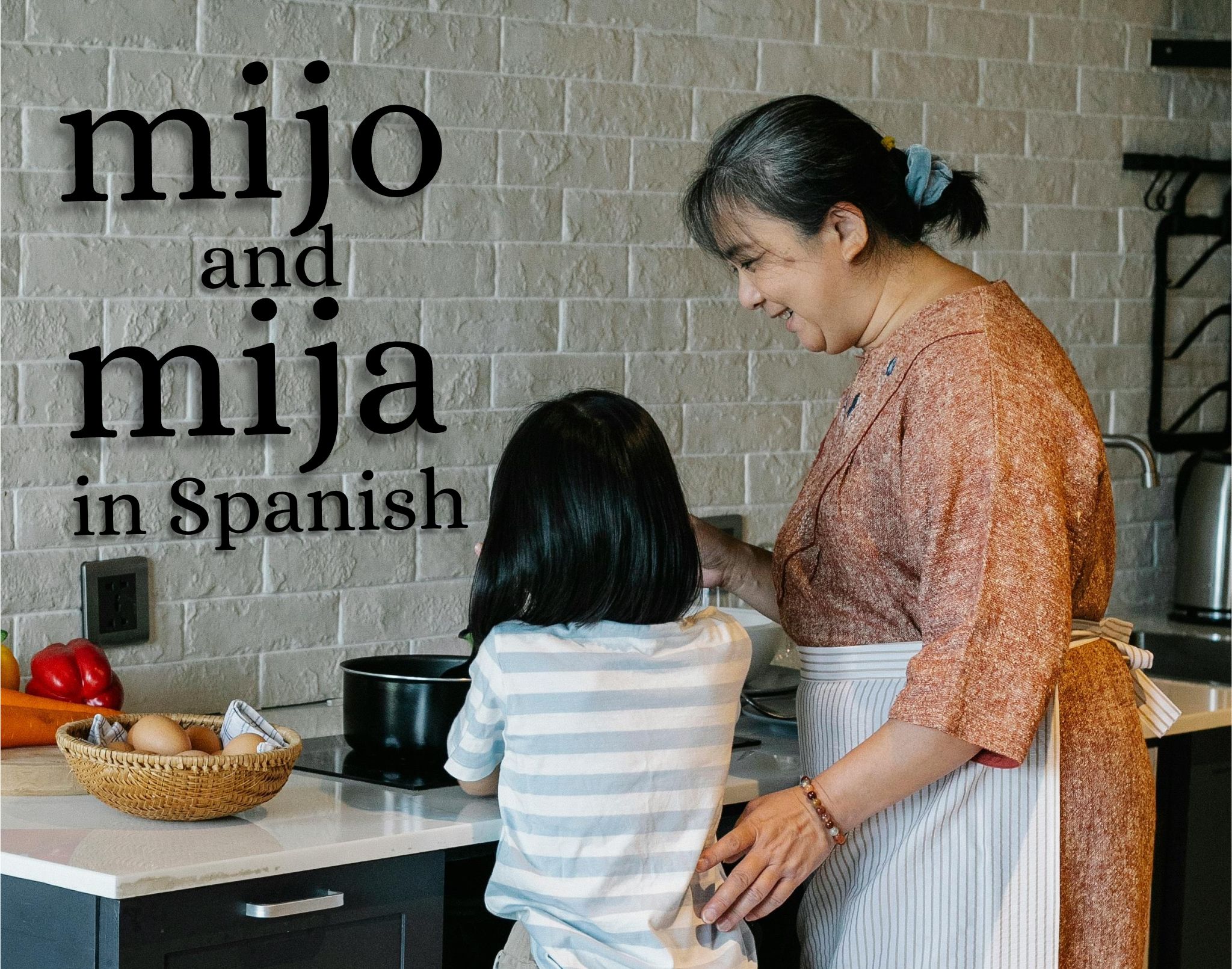Mija and Mijo in Spanish: Versatile terms of endearment

Get our free email course, Shortcut to Conversational.
Have conversations faster, understand people when they speak fast, and other tested tips to learn faster.
More infoIf you’ve been learning Spanish for a while, you’ve surely noticed that we love our terms of endearment. Have you heard people call each other mijo or mija in Spanish and wondered about their meanings?
The Latino culture is widely known for its warmth, and these two terms are an excellent example of our joyful nature. So if you’re learning the language, you’ll want to move beyond grammar and vocab to touch on some of our cultural aspects too!
That’s why today we’ll be devoting our entire post to the Spanish terms of endearment mijo and mija. We’ll start with the straight meaning of mijo and mija, and then go into the various nuances of how to use them. As we do in all our lessons, we’ll provide lots of examples to demonstrate the different scenarios for using mijo or mija in Spanish!
Mijo Meaning in Spanish
Mijo in Spanish has two completely different meanings. Technically, the translation of mijo in Spanish is millet, which is a type of grain. This is not the meaning of mijo that we’re considering here!
The other mijo meaning, with its feminine counterpart mija, is entirely colloquial. It’s used as a very affectionate term of endearment. This is the meaning of mijo and mija in Spanish that we’re looking at in this post.
Mijo in Spanish is a contraction of mi hijo, which translates literally as my son. Its feminine form is mija, short for mi hija, meaning my daughter in English.
In Spanish, people use mijo or mija to refer to:
- their own kids
- kids in general
- a boyfriend or girlfriend
With this in mind, possible translations of mijo and mija may be my son, my daughter, kid, boy, girl, sweetie, honey, or even dude. It all depends on the situation and on who’s being referred to.
Note that although the use of mijo and mija is widespread throughout Latin America, its prevalence across societies sometimes varies. In certain regions it’s really just used by older people, while in others it’s used by nearly everyone.
Now let’s move on and see some scenarios where we might use mijo and mija in Spanish.
When and how to use Mijo in Spanish
Calling kids Mijo or Mija in Spanish
An affectionate way to call kids in Spanish is mijo or mija. Whether the kids are yours or not, mijo is a sweet option if you want to show some degree of affection!
In this case, it’s not exclusively used on young children: mijo and mija in Spanish are also just as good when parents want to address their adult kids with affection.
- It’s so good that you came, son! – ¡Qué bueno que viniste, mijo!
- Merry Christmas, my little sweetie pie! – ¡Feliz Navidad, mija querida!
- Let’s go out and play in the backyard, son. – Salgamos a jugar al patio, mijo.
- Eventually, life will reward you, son. – Finalmente, la vida va a recompensarte, mijo.
The diminutive forms mijito or mijita are good options if you want to increase the intensity.
- Come and hug your mum, sweetie. – Ven y abraza a mami, mijita.
- Are you going to eat more, son? – ¿Vas a comer más, mijito?
- Can you tell me the time, hon? – ¿Me dices la hora, mijito?
- I’m so proud of you, sweetie. – Estoy muy ogullosa de ti, mijita.
Mijo or Mija to refer to a boy or a girl
Mijo or mija can be used to refer to a young member of the family, or even a boy or a girl whose name you don’t know.
In this context, mijo and mija in Spanish can be translated as kid, kiddo, boy, or girl. If you’re talking about more than one kid, the plural forms are mijos and mijas.
- C’mon kids, we’re going to be late! – ¡Vengan mijos, que vamos a llegar tarde!
- Girl, tell your dad we’ve just arrived. – Mija, dile a tu padre que ya llegamos.
- It’s about time to set the table, boys. – Ya es hora de poner la mesa, mijos.
- Please, call your mum, kiddo. – Mijo, llama a tu madre por favor.
Older people also use mijo in Spanish as an affectionate option to address someone younger than them. In this case, the English equivalent of mijo may be dear or honey. The use of the diminutives mijito and mijita in this scenario is very common.
- Would you help me cross the street, dear? – ¿Me ayudas a cruzar la calle, mijo?
- Honey, is there anything else I can do for you? – ¿Mija, puedo hacer algo más por ti?
- Dear, I’ll call you again tomorrow. – Mijita, mañana te llamo otra vez.
- Dear, try to behave yourself better. – Mijito, trata de portarte mejor.
Mijo in Spanish to refer to friends
In some countries, such as Mexico, mijo and mija are commonly used as endearing nicknames when addressing close friends. In this case, mijo in Spanish can be translated along the lines of buddy, pal, or dude.
- Let’s go out and party, sistah! – ¡Mija, salgamos de fiesta esta noche!
- Would you lend me your truck today, pal? – ¿Mijo, me prestás tu camioneta hoy?
- Don’t talk to me like that, buddy. – No me hables así, mijo.
Mijo and Mija in Spanish for romantic partners
Mijo and mija in Spanish are also used between romantic partners. You might hear a girl telling mijo to her boyfriend, or a husband saying mija to his wife. In these cases, English equivalents of mijo and mija can be variants of sweetie, honey, sweetheart, or babe.
- Kiss me, babe. – Dame un beso, mija.
- Have you taken the trash out already, honey? – ¿Ya sacaste la basura, mijo?
- I missed you so much, sweetheart. – Te extrañé mucho, mija.
- Sweetheart, shall we go to the cinema today? – Mijo, ¿vamos al cine hoy?
Mijo and Mija: Variants and Pronunciation
Remember that mijo and mija are shortened forms of mi hijo and mi hija. Mijo and mija are the most common spellings for these contractions, but sometimes we also see it written with an apostrophe rather than as a single word: m’hijo and m’hija.
In terms of pronunciation, the contraction is pronounced with two syllables rather than the original three of the two-word version, regardless of whether it’s spelled mijo / mija or m’hijo / m’hija. The letter h after the apostrophe in the latter variant remains silent. Remember also that the Spanish j is pronounced like the English letter h in words like “hard” or “home.”
For more depth on these details, see our related posts on Spanish contractions, pronunciation in Spanish, silent letters in Spanish, and Spanish syllables.
Conclusion
You’ve just learned a couple of the most important words normally used in Latin America to show love and endearment. Now that you know how and when to use mijo and mija in Spanish, you’re ready to express your affection to a friend, a family member, or even a romantic partner.
We’ve provided you with all possible scenarios, meanings, and ways of using mijo and mija in Spanish, along with examples, variants, and pronunciation. You can’t ask for more, mijo!



